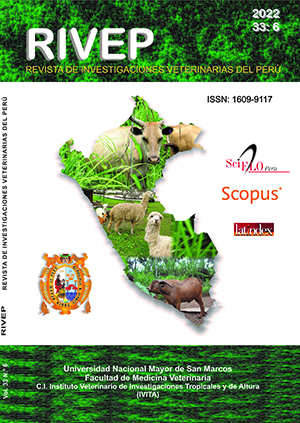Pharmacokinetic model of florfenicol in tilapia (Oreochromis niloticus) subjected to different rearing temperatures
DOI:
https://doi.org/10.15381/rivep.v33i6.22433Keywords:
antibiotic therapy, pharmacometry, fish farming, dosage regimenAbstract
The aim of this study was to develop a pharmacokinetic model of florfenicol in plasma of tilapia (Oreochromis niloticus) subjected to different rearing temperatures to estimate the plasma concentration of the protocols indicated in the package inserts of florfenicol products authorized in Brazil. For this, a pharmacokinetic model was created from previously published data on the plasma concentration of florfenicol in Nile tilapia subjected to different temperatures. The construction of the pharmacokinetic model was carried out with the Lixoft® Monolix 2020R1 program, based on the plasma pharmacokinetic data of florfenicol found in the literature. Plasma concentrations of florfenicol were estimated from treatments with doses of 10, 15 and 20 mg/kg administered every 24 hours for 10 days, at temperatures of 18, 21, 26 and 30 °C, using the Lixoft Simulx 2020 program®. The absorption latency time (Tlag) and clearance (Cl) parameters showed a positive correlation with temperature, while the absorption constant (Ka) showed a negative correlation. Likewise, animals kept at 30 °C have a median mobile plasma concentration of approximately half that of animals raised at 18°C and treated with the same doses. Increasing doses, on the other hand, resulted in an approximately two-fold increase in median plasma concentration. The proposed model allowed quantifying the impact of temperature on pharmacokinetic parameters, in addition to estimating plasma concentrations of florfenicol for tilapia at different rearing temperatures.
Downloads
Downloads
Published
Issue
Section
License
Copyright (c) 2022 Emanuely Ramos Tameirão, Fernando Marcos Rubim, Larissa Alexsandra Felix, Lucas Wamser Fonseca Gonzaga, Humberto de Mello Brandão, Luis David Solis Murgas, Marcos Ferrante

This work is licensed under a Creative Commons Attribution 4.0 International License.
AUTHORS RETAIN THEIR RIGHTS:
a. Authors retain their trade mark rights and patent, and also on any process or procedure described in the article.
b. Authors retain their right to share, copy, distribute, perform and publicly communicate their article (eg, to place their article in an institutional repository or publish it in a book), with an acknowledgment of its initial publication in the Revista de Investigaciones Veterinarias del Perú (RIVEP).
c. Authors retain theirs right to make a subsequent publication of their work, to use the article or any part thereof (eg a compilation of his papers, lecture notes, thesis, or a book), always indicating the source of publication (the originator of the work, journal, volume, number and date).



